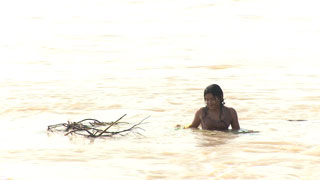The Embrace of the River
Los abrazos del rio BELGIUM, COLOMBIA / 2010 / Spanish / Color / Blu-ray (HD) / 73 min
BELGIUM, COLOMBIA / 2010 / Spanish / Color / Blu-ray (HD) / 73 min
Director, Photography, Script: Nicolas Rincon Gille
Editing: Cédric Zoenen
Sound: Vincent Nouaille
Producer: Manon Coubia
Production Company: VOA asbl voa.magusine.net
World Sales: CBA
The 1,540-kilometer-long Magdalena River flows from western Colombia into the Caribbean Sea. The people who live along its banks have historically revered the Mohán, the spirit of the river who provides their daily sustenance and also takes their lives in aquatic accidents. In a thick, mysterious fog, people offer cigars and local distilled liquor to the Mohán in exchange for a bountiful catch of fish. Stories of encounters with the Mohán are eloquently told, propelled by the flow of the river. Eventually, numerous testimonies regarding floating body parts dismembered in massacres bring us into contact with the realities that Colombia faces today. The film adeptly unites these truths with the river as an intersection of life and death, the living and spirits, and quietly shares the fierce anger and deep sadness of women who have lost their sons and siblings.
[Director’s Statement] The legend of the Mohán is one of the best known in Colombia. It is associated with the great Magdalena River, which crosses the country from south to north, linking the Indian culture of the Andes with Afro-American culture on the Atlantic coast. The legend is considered to be a strong element in the imagination of the country.
Most Colombians who describe his features and habits say the Mohán appears as a solitary shaman. The Spaniards used the term Mohanes for the Pijao Indians, who fled the order established by the Conquest. But the Mohán was wily and did not disappear. A great wizard, with knowledge of age-old practices, he used his powers to resist time. By seducing other men’s women, he managed to maintain his lineage.
The Magdalena River is a story in itself: its birth, its troubled path, and its arrival at the sea are markers that build a time independent of man. As if nature were capable of telling its own story, the current has its own language and talks to us. First it tells us it is impossible to swim twice in the same river. Not only are we minuscule in terms of the temporality of the world, but we can do nothing to stop it. The river also speaks of the depths that hide a world in which we could be lost. Tree trunk, stone, or body, we are just one more object. Diminished, we are obliged to accept the limits of our will. But there is still one way to master this river, to appropriate its meaning: we make stories.
But the Magdalena is also a river that has seen the worst sort of political violence. The bodies that are constantly thrown into its depths, sometimes cut to pieces, are sweeping away the magic.
Linking the progressive discovery of the Mohán with the path of the Magdalena River makes it possible to anchor the legend in the daily life of fishermen.
Will the Mohán disappear one day? Will he take with him the memory of the Indian peoples? Will the magic of the Magdalena be smothered by so many acts of barbarism perpetrated with such apparent impunity? Can violence cancel out everything, even the story that makes memory?
 Nicolas Rincon Gille
Nicolas Rincon Gille
Born in Bogota in 1973. After graduating in economics at the National University of Colombia, he went to the south of the country to meet Indians of the Regional Organization of Indians of Cauca (CRIC). There he met documentary filmmaker Marta Rodriguez, whose advice encouraged him to pursue his desire to make cinema. He completed his studies at the Public School of Cinema of INSAS in Belgium in 2003. His first films were on the themes of exile and immigration: País (2002), about a republican Spaniard, and Azur (2003), about a young Moroccan immigrant. Recently he has been working on a trilogy about the relationship between oral tradition and violence in the Colombian countryside, including En lo escondido (Those Waiting in the Dark, 2007) and The Embrace of the River. He is currently preparing the last part, Noche herida (Wounded Night). |
